Incandescence Read online
Page 7
Roi couldn't see how this comparison explained anything. „The stone following a straight line is simple, for sure. So the spring has to fight to complicate the motion, to make it a circle instead. But what's simple about all the different ways that stones fall, all around the Splinter? Keeping them still, keeping them from falling, seems much simpler to me.“
Zak chirped approval. „A fair comment. All I can do is ask for a little more patience.“ He held up the skin. „This is where the numbers start to help us. You say the spring has to fight to complicate the motion of the stone, to bend it away from the straight line it would prefer to follow. How can we make that hypothesis precise, though?“ He sketched the spring and the stone, then drew in a circle — the path that the stone actually followed — and a straight line, the path it would have followed had it not been tied down.
„How far would the stone travel in a count of one, if the spring wasn't there?“ Zak marked off a small section of the straight path. „And how far does it actually travel?“ He marked a similar section of the circular path. „What is the difference?“ He joined the two marks with a third line, an indication of how far the stone had deviated. „The length and direction of this line is a measure of the effort the spring needs to make, to pull the stone away from its natural motion into the path it actually follows. I call this a weight line, because that's what it measures. I believe weight is nothing more than the difference between preferred and actual motion.“
„So where does the pattern in the numbers come from?“ Roi demanded.
Zak said, „Think about the way the weight line changes as we change the two things we can alter in the experiment. If we make the distance from the stone to the pivot greater, everything I've drawn simply grows in proportion to that distance, including the weight line itself. But if we increase the time it takes for the stone to make one complete rotation, then the distance the stone would travel, or does travel, in a count of one gets smaller. However, not only do those two paths get shorter, the angle between them shrinks as well. So all in all, the separation of their endpoints — the weight line — shrinks in proportion to the rotational period multiplied by itself.
„The pattern in the numbers bears all of this out. The value I calculated reverses these two influences on the weight, canceling their effect, yielding a constant result.“
Roi found it difficult to follow the details of Zak's calculations, but if she stepped back and looked at the overall picture, it was a startling idea. Weight is the difference between preferred and actual motion. What her body felt as it pressed against the floor of a tunnel was a kind of struggle against falling, a struggle she could only perform with the aid of the rock beneath her. What she felt now, the absence of that struggle, only seemed dangerous because in a more normal place any such lapse would be punished with serious injury if it lasted more than a heartbeat or two.
„All right,“ she said. „The principle you're asserting is simple enough, and I think I understand what's happening with the spinning tube. How can this explain the pattern of weights across the whole Splinter?“
Zak said, „For that, we need another experiment.“
He led her across the web, to a tube anchored firmly to several wires. „The axis of this cylinder runs from shomal to junub; the midpoint is precisely on the Null Line.“ He took two stones from his carapace, then placed one gently in the mouth of the tube, and the other beside the tube's midpoint. Both floated where he left them, showing no immediate evidence of motion.
„What do you think will happen?“ he asked Roi.
She thought carefully. „The stone that's a little bit shomal will have a little bit of weight, slowly pulling it toward the Null Line. So given time, it will fall down to the Null Line.“
„So let's wait and see.“
To help pass the time, Zak asked Roi to recount the details of her journey, and they chatted about the different work teams she'd seen, the changes in vegetation from place to place, the rumors of food shortages. As they talked, the first stone did indeed gradually descend into the tube, while the second one remained where Zak had placed it.
As the moving stone approached the fixed one at the midpoint of the tube, Roi said, „I was right, wasn't I?“
„Keep watching,“ Zak insisted.
The stone didn't stop at the center. It kept traveling slowly down the tube, away from the Null Line.
„But there is no weight at the Null Line!“ Roi said. „If you're exactly at the Null Line, you should go nowhere. You don't start falling junub!“ She gestured at the other stone, which continued to float where Zak had left it.
„Move away from the Null Line, and throw a stone across it,“ Zak suggested. He pointed to the slender wire that marked the invisible line, then handed her a projectile.
Roi complied, bracing herself on a cross-wire. The stone didn't quite touch the wire, but it came close before sailing smoothly past it.
„It kept going,“ she mused. That didn't surprise her; she hadn't really expected the Null Line to magically rob the missile of its velocity. So why had she been surprised that the stone that had fallen under its own weight, rather than being tossed, had also kept moving?
She went back to watching the stone in the tube. Eventually, it reached the mouth opposite the one where Zak had placed it. She waited for it to emerge from the tube, but again her guess proved ill-founded. Moving just as slowly as it had at the start, it now reversed its motion and began to fall back into the tube.
„A little junub,“ she said, „means a little weight back toward the Null Line again. And somehow, it all balances out. When the stone first crosses the Null Line, the weight begins to act in reverse, but not enough to halt it completely, only to begin to slow it down. Only when it reaches as far junub as it began shomal does it halt completely. And then it starts the very same motion again, in reverse."
«Right,» said Zak. «But where does this beautiful pattern come from? The weight, the motion, two stones coming together and moving apart?»
«I have no idea,» Roi confessed.
«What comes back to itself, over and over? What repeats itself, endlessly?»
Roi was blank for a moment. «A circle?»
«Yes.»
«I don't see any circle.»
Zak rummaged in his right cavity and fished out a loop of wire. «When we throw a stone here, it looks as if it follows a straight line. But how can we really be sure? Before long it hits the wall of the chamber, and we can't know where it would have gone if it hadn't been stopped. So imagine that the way things move when there's nothing to interfere with them isn't always a perfectly straight line. Suppose that if they're tossed in the right direction, they travel around and around, in a very big circle.»
Roi was perplexed. «How big? As big as the Splinter?»
«Much bigger than that. Imagine a circle so big that you could follow a part of it from one side of the Splinter to the other and not even notice the curve, not even see that it was not a straight line.»
Roi's mind reeled. Crossing from one side of the Splinter to the other. then stretching out far into the Incandescence?
She said, «I understand that we couldn't tell the difference from a straight line. But even if it's true, how would we ever know? Why should we believe it?»
Zak said, «Because of this.»
He produced a second loop of wire and held it together with the first, in such a way that the two circles shared a common center. They did not coincide completely, though; a small angle separated them, so they only actually touched at two points. «Imagine two stones, moving along two circles like these. They come together, they pass each other, they move apart, then they come together again. Over and over.»
Roi pictured it, following two points around the two loops. It was half true: the separation of the two points followed the same pattern as the separation of the two stones. «But these stones aren't going around in circles,» she said. «Not even big ones that might be mistaken for straight li
nes.»
«How do you know that?» Zak countered.
«Because they're right in front of me! They're not moving away from me!»
«And how do you know you're not moving, yourself?»
This was becoming surreal. Roi replied patiently, «Because then I'd slam into the wall of the chamber.»
«And how do you know that wall isn't moving? How do you know the whole Splinter isn't moving?»
Roi tensed her limbs ready to reply, then found she had nothing to say.
Zak said, «I believe the Splinter is moving in a very large circle, around a point far away in the Incandescence. When we let two stones, displaced from each other along the shomal-junub axis, move without interference, they come together, then move apart, just as if they were following two such circles inclined at a small angle to each other. And I believe that the time it takes for the stones to complete their cycle tells us how long it takes for the Splinter to make one orbit around that distant point.»
Roi looked back at the stones. The first one, the «moving» one, had almost returned to the midpoint of the tube. If Zak was right, though, then they were both moving in exactly the same way. There really was no difference between them.
She said, «Then what's the Null Line? Why is it special?»
«The Null Line is a piece of the circle that the center of the Splinter traces out as it moves,» Zak replied.
«But why are things weightless only there,» Roi protested, «and not along other circles?»
Zak gestured at the two stones. «Both of these are equally weightless, because both are free to move along their natural paths. The only real difference between them is that the one at the Null Line has the whole Splinter keeping step with it, so we think of that one as 'fixed' and the other as 'falling'.
„When you're shomal of the Null Line, your unhindered path would be just like the path of the 'falling' stone, but the floors of the tunnels and chambers won't permit you to follow that path, and their refusal is what you feel as weight. The further shomal you are, the greater the difference between your preferred and actual motion, the harder the rock has to push up on you to keep you shomal, and so the greater your weight.“
Roi turned these propositions over in her mind, torn between skepticism and amazement. She was not yet convinced that Zak was right, but she was beginning to see how his grand vision of weight and motion might fit together.
„What about garm and sard?“ she said. She struggled to picture Zak's extraordinary cosmology: shomal and junub pointed out of the plane of the circle that the Splinter followed, and the directions along the Null Line, rarb and sharq, pointed along that circular path. „Is the center on the garmside or the sardside?“ she asked.
„The garmside.“
So garm and sard pointed toward, and away from, the center of the circle. „If I'm garm of the Null Line,“ Roi mused, „but not shomal or junub, the Splinter will still carry me in a circle around the same point. And the same is true if I'm sard. So why can't those circles count as natural motion, just like moving along the Null Line?“
„This is where things become trickier,“ Zak admitted. „I claim that following a circle around one special point comprises natural motion, but I believe that's only true if you're traveling at the right speed. That speed depends on how large the circle is.
„The center of the Splinter must be following its natural path — otherwise objects at the Null Line would not be weightless. On the garmside, though, the circle will be slightly smaller, and on the sardside, slightly larger. The natural motion that corresponds to these circles must involve slightly different orbital periods, but the Splinter is a solid object, it has to move as a whole. Because every part of it must complete an orbit in the same time, there's a mismatch between the speed at which things are moving and the speed of a naturally circular orbit. Wherever there's a mismatch like that, the natural path can't be circular any more.
"On the garmside, the natural path must be more sharply curved than a circle of the same size, because the weight there is directed toward the center of the orbit. On the sardside, the natural path must be less curved than the circle that's actually followed, because the weight is directed outward, away from the center of the orbit."
«That makes sense,» Roi said, «but where does the three come from? Or the two and a quarter?»
«That depends on the precise rule that describes how the natural orbital period varies with the size of the orbit,» Zak replied. «If the period multiplied by itself grows in proportion to the size multiplied by itself, then by itself again, weight should grow three times faster when you move garm or sard than when you move shomal or junub.»
Roi said, «Why choose that rule, though, and not another one? Is it really the simplest one imaginable?»
«I thought there was a way of seeing it that made it perfect,» Zak replied. «So simple it couldn't be otherwise. But now I don't know what to think. The measurements aren't lying, so I'm wrong about something.»
Roi said, «What made it seem so simple? 'The period times the period grows in proportion to the size times the size times the size.' Why is the size taken three times? Why not two? Why not four? Why not five?»
Zak held up the skin and scratched a circle. «This is the orbit of the Splinter. Focus on a small part of the curve, so small it looks like a straight line. That's the Null Line. Now tell me what happens to the direction of that line, as you follow it around one orbit.»
Roi stared at the picture. «It always lies perpendicular to the direction from the Splinter to the center of the circle. Rarb is always perpendicular to garm.»
Zak said, «Yes. But if rarb stays perpendicular to garm, what happens to garm? If you draw a line from the Splinter to the center of the orbit, what happens to that line as the Splinter moves?»
«It moves with the Splinter, it follows it around the circle.»
«Its direction rotates?»
«Yes.»
«So what happens to the Null Line, which is always perpendicular to it?»
Roi tapped her carapace in self-reproach. «The Null Line rotates! With each orbit the Splinter makes, the Null Line itself rotates.»
Zak said, «Yes. So the Splinter doesn't simply travel around this circle, it's also turning as it moves. It rotates around the shomal-junub axis, in exactly the same time it takes to make an orbit. If it wasn't doing that, there would be no Null Line: we would not be weightless anywhere, except at a single point, the center of the Splinter.»
Roi was growing dizzy. First the Splinter was flying through the Incandescence in a giant circle, now it was spinning as it went. «What about the first experiment, though? The one where you spun the tube and the stone gained weight?»
«Yes?» Zak sounded pleased that she'd raised this. «Tell me what that means for the Splinter.»
«We're on the Null Line, but I'm sure we're not precisely at the center of the Splinter. So we're spinning around the center, just like that stone. So why don't we have weight from that spin?»
«I believe we do. But it's balanced by something else.»
«What?»
Zak said, «Suppose we're thirty-six spans rarb along the Null Line from the center of the Splinter. If we're spinning around the center, which way should our weight point?»
«Rarb. Away from the center.»
«But we feel no weight at all. So if you took away the spin, then which way would our weight point?»
«In the opposite direction,» Roi supposed. «Back toward the center of the Splinter.»
«Right. Now, if we were thirty-six spans shomal of the center, which way would our weight point?»
Roi was confused. «Are we spinning now, or not?»
«It makes no difference. The spinning stone had no weight in the direction of its axis. Spinning the Splinter along the shomal-junub axis has no effect on weights in that direction.»
«All right,» Roi said, «then nothing has changed. Our weight would point back toward the center of the Splinter.»
/>
Zak said, «So for any direction other than garm or sard — the directions that take us closer to, or further from, the center of the orbit — our weight would point toward the center of the Splinter itself. And what's more, if you look closely at the calculations, the weight at any given distance from the center of the Splinter would be equally strong, whether you traveled rarb, sharq, shomal or junub. Shomal-junub weight depends on the time for the Splinter to make one orbit, and your distance from the Null Line, in exactly the same way as the weight from spinning depends on time and distance. So if you took away the spin, shomal-junub weight and rarb-sharq weight would be exactly the same.»
Roi said, «Where does that leave the garm-sard weight?»
«You tell me. If the spin was absent, would the garm-sard weight be less or more?»
Spin produced weight away from the center, and the garm-sard weight itself was also away from the center, so part of it could be attributed to the Splinter's spin. «Without the spin, it would be less.»
«Yes,» Zak said. «Less, per span, by exactly the shomal-junub weight.»
«So if it was three times the shomal-junub weight with the spin, then without the spin it would be two?» Roi ventured.
Zak chirped with delight. «Yes! And that is what makes three beautiful. With spin, we can say the weights for the shomal-junub, garm-sard, and rarb-sharq axes are: one toward the center of the Splinter, three away, and zero. But the hidden picture, if we strip away the complication of the spin, is: one toward the center, two away from it, and one toward it again.»
«I can see that garm and sard are special,» Roi conceded. «But why should the garm-sard weight be exactly twice the others?»
«Because that gives a perfect balance between the amount of squeezing and the amount of stretching. Take a package of resin and squeeze it in two directions; I promise you, it will burst out in the third direction, with twice the force. It's not free to do anything else.»

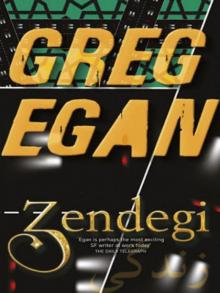 Zendegi
Zendegi Permutation City
Permutation City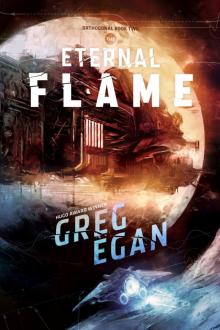 The Eternal Flame
The Eternal Flame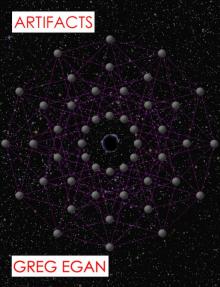 Artifacts
Artifacts Wang's Carpets
Wang's Carpets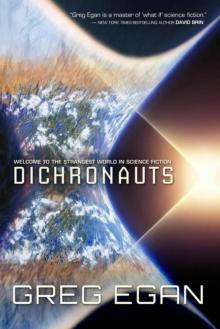 Dichronauts
Dichronauts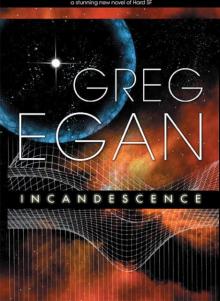 Incandescence
Incandescence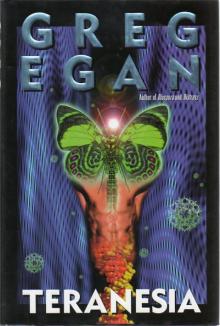 Teranesia
Teranesia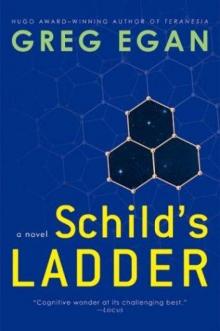 Schild's Ladder
Schild's Ladder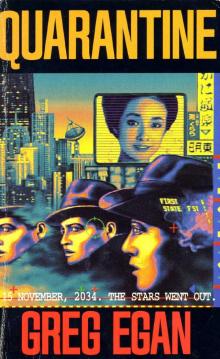 Quarantine
Quarantine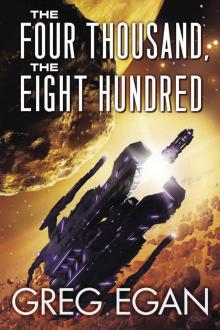 The Four Thousand, the Eight Hundred
The Four Thousand, the Eight Hundred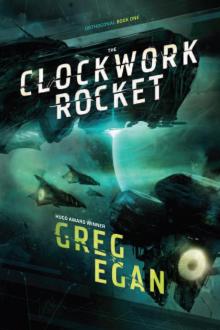 The Clockwork Rocket
The Clockwork Rocket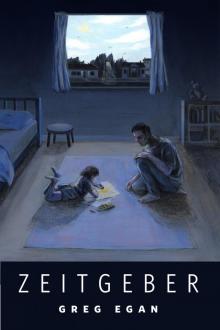 Zeitgeber
Zeitgeber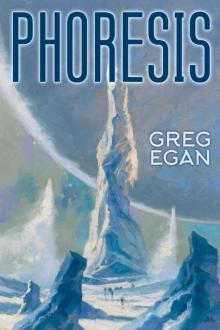 Phoresis
Phoresis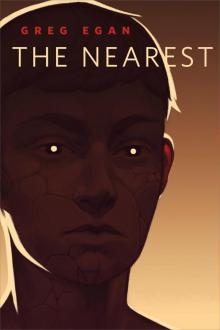 The Nearest
The Nearest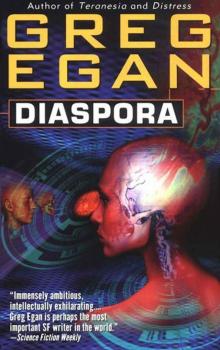 Diaspora
Diaspora Instantiation
Instantiation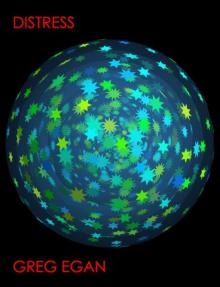 Distress
Distress An Unusual Angle
An Unusual Angle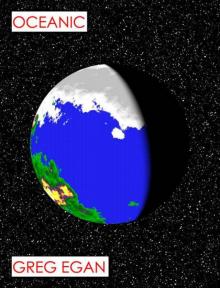 Oceanic
Oceanic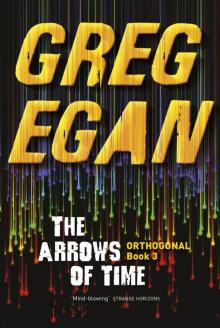 The Arrows of Time
The Arrows of Time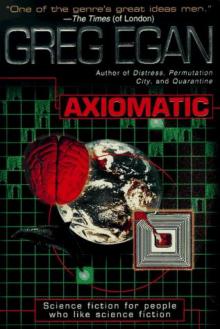 Axiomatic
Axiomatic![Anthology 2. Luminous [1998, 2010] Read online](http://i1.bookreadfree.com/i/03/18/anthology_2_luminous_1998_2010_preview.jpg) Anthology 2. Luminous [1998, 2010]
Anthology 2. Luminous [1998, 2010]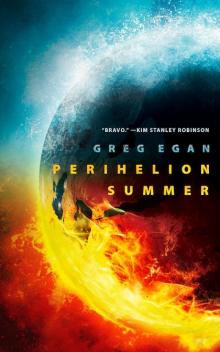 Perihelion Summer
Perihelion Summer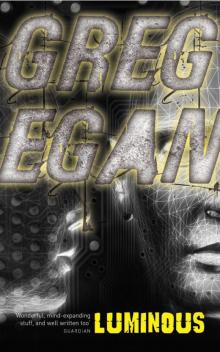 Luminous
Luminous